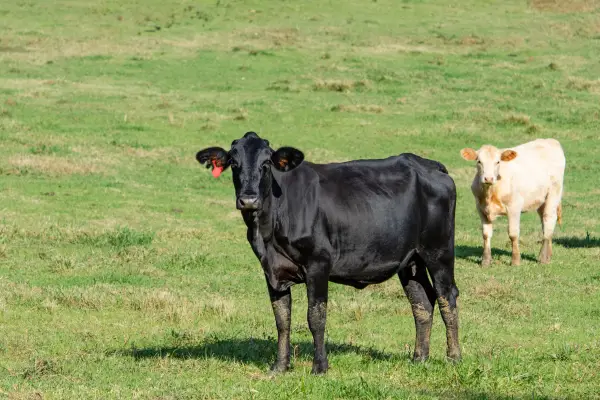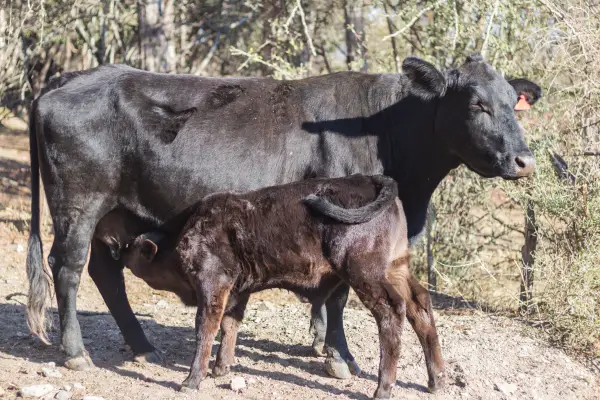Brangus Cattle
Brangus cattle are a cross between Angus and Brahman cattle breeds. They combine the superior traits of heat tolerance from Brahmans and excellent meat qualities from Angus to create a hardy and high quality beef cattle.
Brangus cattle were first developed in the early 1900’s in the southeastern United States which has a hot, humid climate less suitable for typical British breeds.
Where Did Brangus Cattle Originate?
The development of Brangus cattle originated at the USDA Experiment Station in Jeanerette, Louisiana in 1912. The goal was to create cattle that could withstand hot and humid climates while retaining tender beef qualities.
Research veterinarian Dr. Warwick B. Crossley used Brahman bulls on Angus cows, then bred the offspring back to an Angus bull in order to stabilize the positive characteristics of both parent breeds into a new composite breed. This breeding strategy produced the first official “Brangus” herd book in 1949 for pedigree and breeding documentation.
Characteristics of Brangus Cattle
As a stabilized composite breed, Brangus cattle display uniform physical characteristics that set them apart from the parent breeds. They are medium to large framed cattle with a straight back and muscular hindquarters.
Mature bulls weigh from 1,800 to 2,300 pounds while cows range from 1,000 to 1,400 pounds. One of the most distinguishing features is their black, grey, or red coat color, a trait passed down from their Angus ancestry.
This is in contrast to Brahman cattle that exhibit various color patterns. Brangus cattle may display some spotting around the neck but have a solid color over the back and hindquarters.
Additional traits characteristic of Brangus cattle include:
- Black skin pigmentation for UV protection
- Loose, pendulous skin for heat dissipation
- Large droopy ears with eye pigmentation
- Smaller thoracic hump than Brahman cattle
- Polled (naturally hornless) genetics common
- Highly social temperament for easy handling
Facts About Brangus Cattle
Here are some interesting facts about this popular American cattle breed:
- Brangus females are known for ease of calving due to Angus genetics
- They exhibit hybrid vigor – increased performance over purebred parents
- Brangus bulls are commonly used for crossbreeding programs
- There are over 775,000 registered Brangus cattle in the U.S.
- International Brangus Breeders Association formed in 1949
- They consume 20-40% less feed than other British breeds
- Brangus bulls have high libido and breeding longevity

What Are Brangus Cattle Used For?
The traits of Brangus cattle make them exceptionally well suited for several purposes:
1. Beef Production: Excellent meat quality and high dress out percentages have established Brangus-influenced cattle as premier commercial beef producers. Crossing Brangus bulls with other breeds has become a popular method to increase hardiness and carcass value.
2. Maternal Line: Brangus females are outstanding mother cows due to fertility, sound udders, and protective instincts. They excel in harsh environments and produce valuable calves when bred to other beef breeds.
3. Tropical Climates: Their Brahman lineage provides Brangus cattle with heat tolerance and insect resistance necessary for thriving in hot, humid regions. They are a staple breed in the southeastern U.S., Australia, Africa and Central & South America.
4. Crossbreeding Programs: Brangus bulls have been fundamental in the development of numerous emerging composite breeds like Beefmaster, Simbrah and Santa Gertrudis designed for specific traits like tropical adaptability or optimum carcass yield. This demonstrates their importance for phenotypic and hybrid vigor impacts as a terminal breed.
What Are Brangus Cattle Known For?
In addition to tropical climate adaptability, fertility and maternal abilities, Brangus cattle have earned a well-deserved reputation for:
- Excellent marbling and meat tenderness
- High dressing percentage – 60%+ hot carcass weight
- Lean yet well-muscled cuts
- Calm disposition for ease of handling
- Heat tolerance and longevity in challenging environments
- Disease resistance, especially parasites & mastitis
For commercial beef producers, Brangus-influenced cattle repeatedly prove themselves for profitable production in terms of reproductive efficiency, calf survival rates and top-quality market animals. Their exceptionally flavorful meat consistently grades USDA Choice or Prime to meet demanding consumer preferences.

How to Judge Brangus Cattle in the Show Ring
Judging Brangus cattle necessitates close attention to breed standards regarding confirmation, musculature, capacity and balance. Judges evaluate:
Masculinity – Bulls should display thick, well-defined muscling especially in the hindquarters, shoulders and loin area, combined with adequate testicular development to ensure breeding capacity and fertility. Deficiencies like narrowness through the chest or female-like features are undesirable.
Maternal Traits – Ideal udder shape is snugly attached with well-spaced square teats indicating ample milk supply. Capacious, well-formed udders without abnormalities along with feminine head and neck are positives for females.
Frame Size – Moderate stature to support muscle without excessive skeletal size is ideal, adhering to height parameters based on age. Extreme heights causing structural weaknesses or slower maturity should be marked down.
Disposition – An even temperament and manageable behavior under close inspection and handling is preferred over nervous, aggressive or flighty reactions.
Heat Tolerance – Excess skin around the neck, darker pigmentation and large droopy ears provide cooling effects in hot climates and should be favored. Sparse hide or minimal ear size reduces adaptation.
Carcass Merit – Wide, thickly fleshed rump and hindquarters with trim and tightly held abdomen over skeletal angularity reflect carcass cutability and yield. Flashy dimension through the forequarters also impressive.
To some extent, deviations are permissible such as birthmarks or scurs. However, disproportionate features, color deviations and anatomical abnormalities should be discriminated against. Condition & smoothness of finish is assessed relative to stage of growth or age.
Pros and Cons of Brangus Cattle
Pros:
- Maternal traits – fertility, milking ability, longevity
- Carcass quality – marbling, tenderness, high dress out
- Adaptability – heat & disease tolerance
- Disposition – docile & easy to manage
- Hybrid vigor & heterosis utilization
- Libido & breeding capacity of males
Cons
- Not suitable for extremely harsh cold climates
- May display aggressiveness during mating seasons
- Large ears prone to injury or sunburn
- Brahman lineage causes calving difficulty in heifers
- Spotting sometimes appears on legs or belly
Conclusion
Cattle Brangus cattle have proven themselves as an extremely useful breed for challenging climates and varying production systems. They were initially created for the hot southern United States, but have expanded to become a valued genetics resource worldwide, including Australia, Africa, South America and parts of Asia.
Their heat-adapted nature, hardiness, fertility, docility and beef qualities have positioned the Brangus breed as an innovative solution to global cattle production. With increased pressure for sustainability and climate change resilience in agriculture, hardy and multi-purpose cattle genomes like Brangus will undoubtedly continue growing in popularity across the globe. Their strengths seem profound, while their minor weaknesses can be easily overcome through strategic breeding plans.


